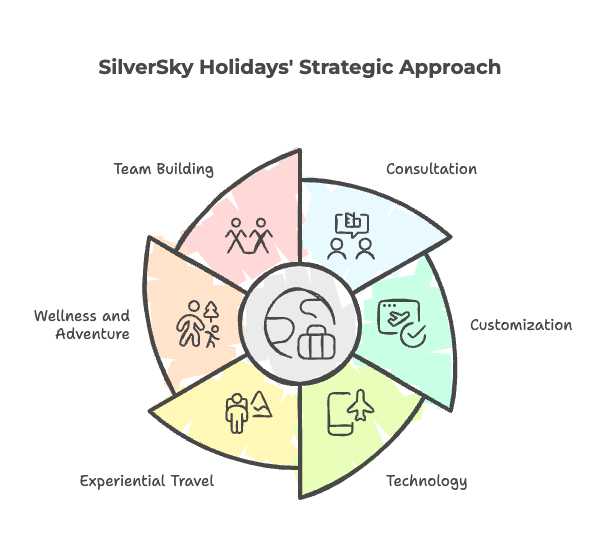The Indian traveler has stepped into a new era of intent, personalization and technology. Building off of the accelerated adoption of digital technologies and ‘revenge travel’ in 2025 after COVID, we are seeing a simple set of sophisticated travel trends outlining where and how Indian tourists will travel in 2026. The new journey is no longer about escaping, but about being expressed self, establishing a real connection and making your rupee and moment count.
This in-depth long-form piece explores the seismic changes in the past to predict the main hotspots, experiences, and technologies that will shape Indian tourists’ itineraries next year. Get ready to plan a future ready adventure.

Popular Indian Holiday Destinations: The Boom in Personal Travel
In 2025, Indian travelers settled on the domestic destinations of culture and calm and went beyond the common Golden Triangle. This trend will continue momentum in 2026 to an even larger focus on “personal travel” which are travels with passionate and personal identity and heritage significances.
Established destinations will continue to lose popularity to off-the-beaten-path destinations that offer real cultural immersion. Jorhat, Assam, for example as a new popular domestic culture and calm destination has tremendous growth potential for pleasure travel.; a cultivator of calm and eco values (as it is the gateway to Majuli, the world’s largest river island); and cultural experiences. Varanasi will also gain popularity as it is transitioning to more than just a pilgrimage destination to younger travelers who seek heritage walks, boutique accommodations and local spiritual retreats. Southern and western India also fares well with popular offerings from around Tirupati as value will remain the travel veracity with departures from regional flight price drops along with spiritual value. However, while establishing new travel habits in 2025, the most significant action was avoidance and the search for avoidance of over crowded places; this is evolving to discovering authentic and lesser-visited domestic destinations in India to travel within 2026.
“Data analyzed on bookings for 2025 indicates that one in three Indian travelers is avoiding popular destinations altogether and opting for more genuine and quieter spaces across the world. This trend of ‘personal travel’ has shifted the domestic map and travelers in 2026 are looking at places such as Jorhat, and the deeper cultural lanes of Varanasi, as aspirational.”
International Hotspots: Price, Access, and Novelty
There are two things that affect international choices for Indian tourists in 2026. First, ease of transactions (thanks to digital infrastructure), and second, strategic cost-effectiveness. In 2025, things were stable, which made travelers more willing to book trips further in advance and go to places that gave them a high return on experience (ROE).
Southeast Asia and the Middle East are still important, but new competitors are quickly rising. Muscat, Oman is becoming very popular. It offers travelers a unique non-2nd tier option that combines ancient Arabian tradition with modern comforts. This is attracting discerning travelers who want an elegant, forward-looking, and exciting alternative to its more flashy and comparable neighboring destinations.
Queenstown, New Zealand is getting a lot of attention from thrill-seeking travelers looking for something new. The extreme sports there are set against the stunning backdrop of the Alps. It’s clear that there has been a shift toward mountain getaways all year round.
Jaffna, Sri Lanka is getting a lot of attention right now, especially because of a new direct flight and better travel connections. The city’s rich cultural heritage also speaks to and resonates with South Indian travelers. The widespread use of UPI payments around the world (a major development in 2025) in many travel areas (France, the UAE, and possibly even more places in 2026) will be a key part of the growth of cross-border travel. This will give travelers more confidence by making it easier to make transactions when they are abroad and when they cross a border.
“The step expansion of India’s UPI ecosystem in 2025 outside expressly India’s borders was a watershed moment for Indian tourists. A place that lets you pay with your phone without any problems removes a lot of stress. In 2026, Indian tourists will be able to travel to places that are fundamentally better, more appealing, and less stressful than they are now. These places could be anywhere from Japan to Singapore or even a brand-new travel market.”
New Types of Experiences (Wellness, Adventure, Remote Work)
The primary driver for Indian tourists in 2026 is not just where they go, but equally, what they do. A more active, purposeful form of engagement, what we have observed as a shift from passive tourism, is clearly evidencing the new experience landscape post-COVID.
Wellness and “Glowmads” Travel 🧘♀️
Wellness is a foundational premise. Tourists are integrating beauty, mental and physical health into their itineraries. The Glowmads trend indicates travelers are selecting their destinations based on self-care opportunities–geeked-out Ayurvedic healing spas in Kerala, yoga ashrams, or sourcing locally-produced skincare products in destinations abroad. Experience is not a day at the spa; it’s a full-on pursuit of holistic renewal or mindful travel.
Adventure and Altitude Shift 🏔️
The love for mountains is developing and transitioning into a year-round trend, an “Altitude Shift.” Indian tourists in 2026 will be increasingly booking alpine and high-altitude holidays outside of the traditional winter snow-stuffed months. The emphasis is on trekking, hiking, and mountain retreats, with associations around achievement and human connection to nature. Himachal Pradesh will continue to provide high-quality adventure, with other more intriguing adventure circuits outside of the mountains.

The Development of the Workcation 💻
The workcation was its same stated of being viable back in 2025; 2026-we see strategic aspects. Now, Digital nomads are selecting unique and quiet settings like Pondicherry or the peaceful side of Goa, which provide a work-life cycle not to be confused with a comfortable desk with a view. The Internet must be good, and the environment must be suitable for productivity and relaxation! This is one of the critical areas for these travelers of long stays—such considerations are a priority for corporate group travel organized on the group’s behalf for an offsite.
“We are seeing the convergence of passions and places as part of the 2026 outlook. Trips are built around hobbies, whether that’s bird-watching, literature inspired travel, food journeys called “Shelf Discovery” (grocery stores), etc. This hyper-personalization is the fundamental distinction between the pre-pandemic traveler and the future-ready Indian traveler.”
Tech in Travel: AI Trip Planners and Hyper-Personalization
Technology is the invisible force in the 2026 travel experience of the Indian visitor, from a booking tool to a personalized travel companion. The high levels of confidence in digital tools demonstrated in 2025 (with a significant majority of Indian travelers expressing comfort with the use of AI for trip planning) will promote and allow even greater confidence to delve further into travel.
AI Trip Planners will become essential and will utilize generative AI-trip-planning to produce everything from a daily itinerary of itinerary details individualized to micro-preferences – a level of detail no consumer-facing human travel agent could produce with anything close to the efficiency of technology – to the personalization of the on-the-ground experience of travel. Picture an AI-enabled app of a traveler with interest in Rajasthani art receiving a discount code for a particular local gallery in Jaipur based on booking history and real-time location. The ongoing evolution of biometrics like DigiYatra in Indian domestic airports raises the expectation that a truly frictionless travel experience will be possible both domestically and for travel abroad. This also aligns with the continuing evolution of pre-experience Virtual Reality (VR) – enabling travelers to ‘test drive’ a heritage hotel room or context for an adventure experience prior to investing considerable costs to experience something for a few days and mistaking it for a vacation experience.
“The shift for 2026 is from ‘Digital Adoption’ to ‘Intelligent Utility.’ Indian travelers are the most confident in the world when it comes to utilizing AI to plan and book travel. For the travel industry, AI is not only necessary, but will create a space where traveler engagement can relate to hyper-personalized suggestions to support the seamless experience the modern traveler has come to expect.”
How SilverSky Holidays Engages Trends
At SilverSky Holidays (SST), we acknowledge that staying ahead of the evolving travel trends is a must for maximizing value. Our approach is not reactionary; it’s a forward-thinking approach based on consultation, customization, and technology.
At SilverSky Travel (SST), we go beyond just ticket control — we offer complete travel management solutions for corporate group travel, with offices in Delhi and Himachal Pradesh. We offer a strategic, consultative, and technological approach to travel management. We aim to deliver value, savings, and superior levels of service.
For 2026, SST is specifically focused on experiential corporate group travel. We are moving MICE (Meetings, Incentives, Conferences and Exhibitions) trips away from generic city hotels to customized retreats, in line with wellness and adventure trends. This would entail booking corporate group travel to boutique destinations in Himachal Pradesh or custom heritage stays in Rajasthan with incorporated team building activities, such as a guided trek or local cooking classes. We have a data point from 2025 post-pandemic travel reflecting a long-term preference for shorter and high-impact getaways to create itineraries that build engagement with best-in-class experience and intention. By applying our strategic and consultative approach, we ensure every SST corporate booking will be an integrated experience along the continuum of organization goals, employee welfare, and cost.

“Today’s business trip is more than a meeting; it is about the motivation and the experience of travelling together. At SilverSky Holidays, our ambition is to create a revolution in corporate group travel from being a logistical requirement to being a strategic employee engagement tool, embracing the demand for responsible and experiential agendas. We believe group around wellness travel will be the next frontier for Corporate India.”
Future-Ready Travel 🌟
The 2026 Travel Trends outlook for the Indian Tourist is confident, purposeful, and personal discovery. Taking lessons from resilient travel behaviour coupled with a digital transformation in 2025, the Indian tourist is expecting more; more authenticity, more personal connection, and more frictionless, seamlessly integrated digital travel experiences through artificial intelligence and a universally accepted digital payments economy.
From emerging domestic highlights such as Jorhat to international favorites like Muscat, and from an all inclusive-style experience of a wellness retreat to the Alpine-like efficiency of AI trip planners, the Journey Ahead is diversified, rich, and rewarding. Indian tourists are ready to connect to the most meaningful adventures yet, through a future-ready, strategic and personalized travel management platform like SilverSky Holidays.

